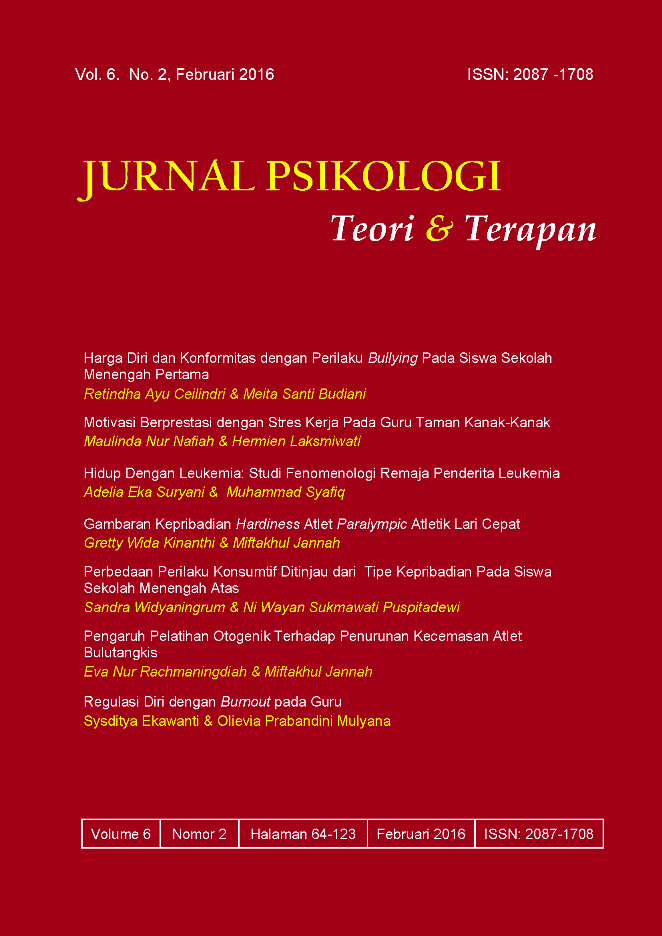Gambaran Kepribadian Hardiness Atlet Paralympic Atletik Lari Cepat
DOI:
https://doi.org/10.26740/jptt.v6n2.p91-101Keywords:
kepribadian hardiness, stres, atlet, paralympicAbstract
This research was motivated by a phenomenon of paralympic athletes with physical, visual, hearing and intellectual dissabilities that were demanded to keep confident and overcome problems. Stress often happens to athletes when the match is in progress so this stress causes failure on their competition and they are demanded to come up again after failure. Athletes need a tendency of hardiness personality to overcome every problem in the match so the atheletes can gain an achievement. The purpose of this research was to describe a paralympic athletes tendency of hardiness personality. This research used qualitative research with case-study method. A paralympic athelete who had international achievement in 200 and 400-meter sprints was recruited as the participant in this research. Data were collected using interviews, observations and document reviews which then analyzed by using thematic analysis. The results showed that the participant had tendency of hardiness personality shown by his understanding of the purpose of life, involving his self in daily activities, and controlling each of his problem. The participant also had optimism and ready to take the challenge.
Abstrak: Penelitian ini dilatarbelakangi oleh fenomena atlet paralympic dengan ketidakmampuan secara fisik, penglihatan, pendengaran dan intelektual yang dituntut untuk tetap percaya diri dan mampu mengatasi permasalahan. Stres seringkali terjadi pada atlet ketika pertandingan berlangsung sehingga stres ini menyebabkan kegagalan dipertandingannya dan mereka dituntut untuk bangkit kembali setelah kegagalan. Atlet membutuhkan kecenderungan kepribadian hardiness untuk mengatasi setiap masalah dalam pertandingan sehingga atlet dapat mencapai prestasi. Tujuan penelitian ini adalah untuk menggambarkan kecenderungan kepribadian hardiness atlet paralympic. Penelitian ini menggunakan penelitian kualitatif dengan metode studi kasus. Atlet paralympic yang memiliki prestasi tingkat internasional nomor perlombaan lari cepat 200 dan 400 meter dipilih sebagai partisipan pada penelitian ini. Data dikumpulkan dengan wawancara, observasi dan dokumentasi. Hasil menunjukkan bahwa partisipan memiliki kecenderungan kepribadian hardiness yang ditunjukkan dengan pemahamannya pada tujuan hidup, melibatkan diri dalam aktivitas sehari-hari, pengendalian setiap masalah. Partisipan juga memiliki optimis dan berani mengambil tantangan.
References
Adisasmito, L.S. (2007). Mental Juara: Modal Atlet Berprestasi. Jakarta: PT. Rajawali Grafindo Indonesia.
Besharat, Mohammad Ali. (2011). Moderating Effects of Self-Confidence and Sport Self-Efficacy on the Relationship between Competitive Anxiety and Sport Performance. Journal of Scientific Research 2 (7), 760-765. (online). http://www.scirp.org. Diakses 23 maret 2015.
Conroy, D. E., Poczwardowski, A., & Henchen, K. P. (2001). Evaluative Criteria and Consequences Associated With Failure and Success for Elite Athletes and Perfoming Artist. Journal of Applied Sport Psychology 13, 300-322. (online). http://psicdesp.no.sapo.pt. Diakses 23 Maret 2015.
Dogaheh, E.R., Khaledian, M., & Arya, A.R.M. (2014). The Relationship of Psychological Hardiness with Emotional Intelligence and Workaholism. Iranian Journal of Clinical Psychology (IJCP) 2 (1). (online). http://jpcp.uswr.ac.ir. Diakses 23 Maret 2015.
Griwijoyo, S. (2005). Manusia dan Olahraga. Bandung: Institut Teknologi Bandung.
Herman. (2011). Psikologi Olahraga. Jurnal ILARA 11 (2), 1-7. (online). http://digilib.unm.ac.id. Diakses 23 Maret 2015.
Johnson, B.F., Richter, K., Musheet, C.A., and Peacock, G. (2004). Sport for Athletes with Physical Disabilities: Injuries and Medical Issues. (online). http://www.blazesports.org. Diakses 22 Oktober 2015.
Kreitner, R. dan Kinicki, A. (2005). Perilaku Organisasi. (Alih Bahasa: Erly Suandy). Jakarta: Salemba Empat.
Locke, E. A. (2002). Setting Goals for Life and Happiness. In Snyder & Lopez, Handbook of Positive Psychology. New York: Oxford University Press.
Mehrparvar & Mazaheri. (2012). A Comparative Study of Psychological Hardiness in Athlete and Non-Athlete Students. European Journal of Experimental Biology 2 (5), 1514-1516. (online) http://pelagiaresearchlibrary.com. Diakses 22 Oktober 2014.
Nurhasan, Priambodo, A., Roepajadi, J., Indriarsa, N., Ivano, A.R., Christiana, Y.H.S., Tjateri, G.A., Juniarto, P., Djawa, B., & Wibowo, S. (2005). Petunjuk Praktis Pendidikan Jasmani. Surabaya: Unesa University Press.
Sari, R.I. (2013). Hardiness dengan Problem Focus Coping pada Wanita Karir. Jurnal Online Psikologi 1 (2). (online). http://ejournal.umm.ac.id. Diakses 13 Januari 2015.
Snyder, C.R., Rand, K. L., & Sigmon, D. R. (2002). Hope Theory: a member of the positive psychology family. In Snyder & Lopez, Handbook of Positive Psychology. New York: Oxford University Press.
Wadey, R.G. (2009). An Examination of Hardiness Throughout The Sport Injury Process. (online). http://core.ac.uk. Diakses 21 Oktober 2014.
Downloads
Published
How to Cite
Issue
Section
License
Authors who publish in this journal agree to the following terms:
Copyright in any article is held by the author.
The author grants the journal, publication rights with the work simultaneously licensed under a Creative Commons Attribution License that allows others to share the work with an acknowledgment of the work's authorship and initial publication in this journal.
Authors may enter into separate, additional contractual arrangements for the non-exclusive distribution of the journal's published version of the work (e.g., posting it to an institutional repository or publishing it in a book), with an acknowledgment of its initial publication in this journal.
Authors are permitted and encouraged to post their work online (e.g., in an institutional repository or on their website) prior to and during the submission process, as this can lead to productive exchanges, as well as earlier and greater citation of published work.
 Abstract views: 1697
,
Abstract views: 1697
, PDF Downloads: 1145
PDF Downloads: 1145


















